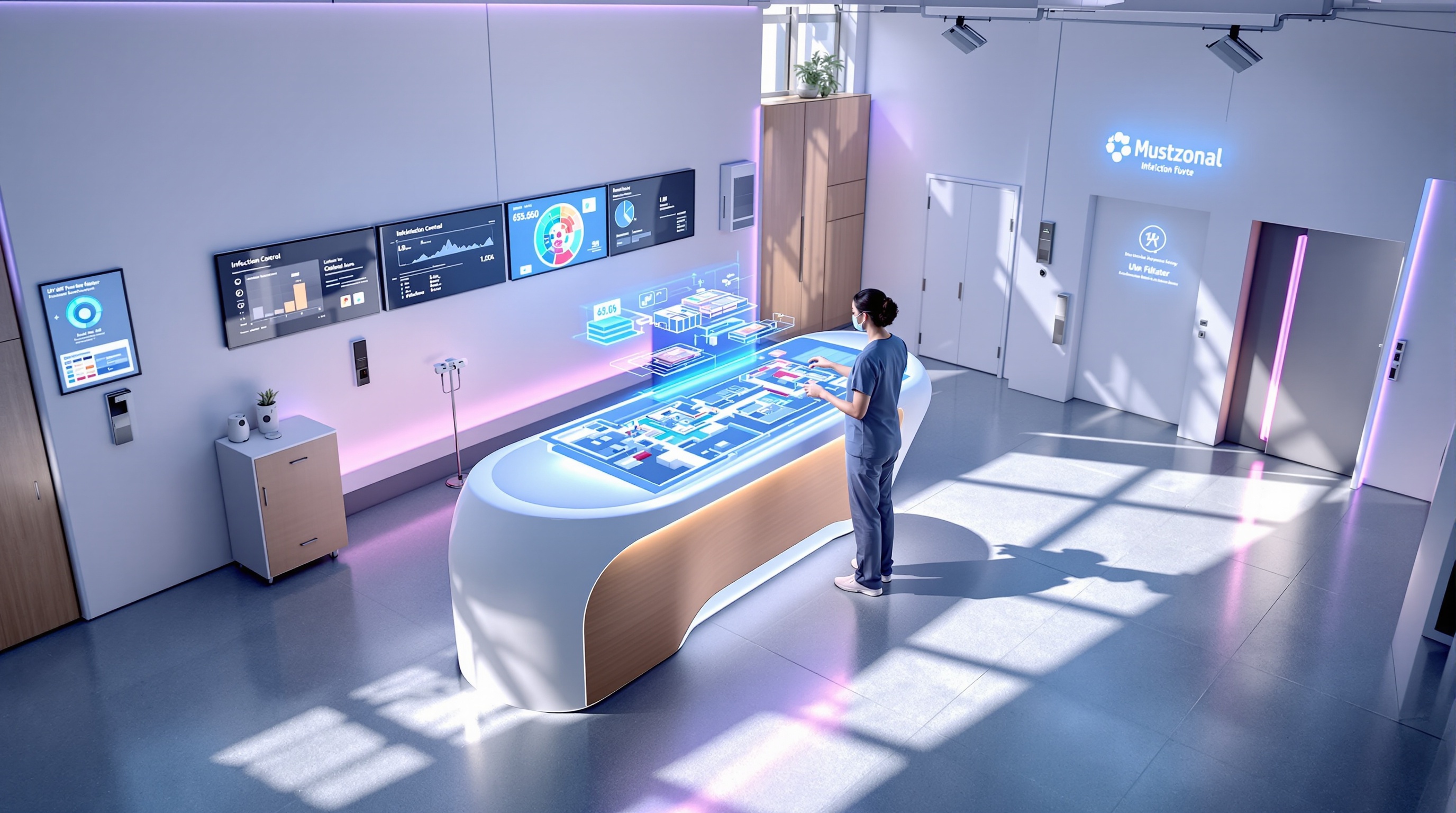F880 Infection Control Automation: Boost Compliance in SNFs
Discover how F880 infection control automation streamlines compliance, reduces risk, and enhances resident safety in skilled nursing facilities.
Quick Navigation
- 1. Introduction
- 2. Current Challenges in F880 Infection Control Automation
- 3. How Sparkco AI Transforms F880 Infection Control Automation
- 4. Measurable Benefits and ROI
- 5. Implementation Best Practices
- 6. Real-World Examples
- 7. The Future of F880 Infection Control Automation
- 8. Conclusion & Call to Action
1. Introduction
Did you know that over 60% of regulatory citations in skilled nursing facilities (SNFs) are related to infection control deficiencies? As the Centers for Medicare & Medicaid Services (CMS) continues to prioritize resident safety, F880—the federal regulation governing infection prevention and control—remains a focal point during annual surveys. The heightened scrutiny comes as older adults, who make up the bulk of SNF residents, are uniquely vulnerable to infectious diseases such as COVID-19 and seasonal influenza. Despite ongoing training and policy updates, many facilities still struggle to maintain compliance with F880, putting both residents and staff at risk and exposing organizations to costly penalties.
The challenge? Manual infection control processes are time-consuming, prone to human error, and often fail to adapt quickly to evolving threats. As requirements become more complex—such as the CMS mandate for a dedicated infection preventionist—facility leaders are searching for solutions that streamline compliance without sacrificing quality of care. This is where infection control automation steps in, offering the promise of real-time monitoring, data-driven decision-making, and consistent documentation.
In this article, we’ll explore the current landscape of F880 regulations, the common pitfalls that lead to deficiencies, and how automation technology is revolutionizing infection prevention in skilled nursing facilities. Discover actionable insights, real-world examples, and practical steps you can take to protect your residents and maintain regulatory compliance.
2. Current Challenges in F880 Infection Control Automation
The Centers for Medicare & Medicaid Services (CMS) F880 regulation requires skilled nursing facilities (SNFs) and other healthcare organizations to maintain rigorous infection prevention and control programs. While automation technologies promise to facilitate compliance and improve outcomes, facilities face a range of challenges when implementing and maintaining F880 infection control automation. Below are some of the most pressing pain points, supported by recent research and industry data.
-
1. Integration with Legacy Systems
Many healthcare facilities operate with multiple legacy electronic health record (EHR) systems and disparate applications. Integrating new automated infection control solutions with these older platforms is complex and often costly. According to a 2023 HealthIT.gov report, only 39% of hospitals report seamless data exchange between systems, creating significant barriers to automated infection tracking and reporting. -
2. Data Accuracy and Completeness
Automated infection control relies on accurate, real-time data entry. However, studies show that manual data input errors and incomplete records remain prevalent. A 2022 study in the Journal of the American Medical Informatics Association found that 27% of infection control data entries contained errors that could affect surveillance and compliance reporting. -
3. Staff Training and Adoption
Successful implementation of infection control automation hinges on staff proficiency. Many healthcare workers are unfamiliar with complex new systems, leading to underutilization or misuse. According to a 2023 Becker’s Hospital Review survey, 65% of facilities report ongoing challenges with EHR and infection control system training. -
4. Cost Constraints
Budget limitations are a major obstacle, especially for smaller facilities. The upfront costs of automation—hardware, software, training, and ongoing maintenance—can be prohibitive. A 2022 Modern Healthcare analysis showed that 52% of small hospitals cite cost as the primary reason for delayed adoption of new automation technologies. -
5. Regulatory Complexity and Updates
F880 guidelines are frequently updated to reflect emerging infection threats and new best practices. Keeping automation systems current with the latest standards requires ongoing investment and vigilance. Facilities report confusion about how to align automated workflows with evolving CMS requirements, risking non-compliance and potential penalties. -
6. Interoperability and Standardization Issues
Lack of uniform standards for infection control automation leads to poor interoperability between systems and organizations. This fragmentation hinders coordinated outbreak responses and comprehensive data analysis. According to the American Health Information Management Association (AHIMA), 57% of healthcare leaders rank interoperability as a top barrier to effective infection surveillance. -
7. Impact on Workflow and Patient Care
When automation tools are poorly integrated, they can disrupt clinical workflows and distract staff from direct patient care. A recent JAMA study reports that 44% of clinicians feel that poorly designed automation increases administrative burden, potentially delaying infection interventions and impacting patient safety.
These challenges have significant implications for operations, regulatory compliance, and patient care. Inefficient automation can increase administrative workload, lead to compliance errors, and ultimately compromise infection prevention efforts. Addressing these pain points is essential for healthcare facilities striving for F880 compliance and the highest standards of patient safety.
3. How Sparkco AI Transforms F880 Infection Control Automation
The Centers for Medicare & Medicaid Services (CMS) F880 regulation sets rigorous standards for infection prevention and control in skilled nursing facilities. Compliance requires constant vigilance, comprehensive documentation, and rapid response to emerging threats—demands that often stretch existing resources. Sparkco AI offers a transformative solution, automating infection control processes and empowering facilities to achieve and maintain F880 compliance with greater efficiency and precision.
-
Real-Time Surveillance and Early Detection
Sparkco AI continuously monitors facility data, including resident symptoms, staff health logs, and environmental factors. Its sophisticated algorithms rapidly identify abnormal patterns or potential outbreaks, instantly alerting infection control teams. This proactive approach enables swift intervention, minimizing the risk of transmission and ensuring adherence to F880’s requirement for timely identification and response. -
Automated Documentation and Reporting
Manual record-keeping is time-consuming and error-prone. Sparkco AI automates the capture, organization, and storage of all infection control activities—from screening logs to disinfection schedules. The platform generates comprehensive, audit-ready reports at the click of a button, simplifying compliance and easing the burden of CMS inspections. -
Intelligent Task Scheduling and Workflow Optimization
Sparkco AI dynamically schedules cleaning, disinfection, and staff training activities based on real-time facility needs, regulatory requirements, and risk assessments. By automating routine tasks and prioritizing critical interventions, the platform ensures that no step is overlooked, helping facilities consistently meet—and even exceed—F880 infection prevention standards. -
Staff Training and Competency Tracking
Staying compliant means ensuring staff are regularly trained and up-to-date on the latest infection control protocols. Sparkco AI automates training reminders, tracks completion rates, and assesses staff competency, providing administrators with actionable insights to address knowledge gaps and maintain a well-prepared workforce. -
Seamless Integration with Existing Systems
Sparkco AI is designed for interoperability, connecting easily with your facility’s electronic health records (EHR), environmental services, and communication platforms. This integration ensures smooth data flow, eliminates duplicate entries, and enables a unified infection control strategy across all departments—without disrupting established workflows. -
Customizable Alerts and Policy Enforcement
The platform’s AI-driven alert system delivers targeted notifications to the right personnel—whether it’s a reminder to isolate a resident, update a cleaning log, or review a policy change. Facility-specific protocols can be embedded and enforced automatically, ensuring consistent adherence to both CMS and internal standards.
By combining real-time analytics, intelligent automation, and seamless integration, Sparkco AI not only streamlines F880 infection control compliance but also enhances overall facility safety and operational efficiency. With Sparkco AI, skilled nursing facilities gain a powerful ally in their commitment to delivering the highest standards of care and infection prevention.
4. Measurable Benefits and ROI
Automating infection control processes to meet CMS’s F880 requirements is transforming skilled nursing facilities. F880 infection control automation leverages digital tools to streamline surveillance, reporting, and compliance, yielding significant returns on investment (ROI) and measurable operational benefits. Below are key, data-driven benefits supported by industry research and case studies.
-
Up to 60% Reduction in Staff Time Spent on Audits
Automating infection surveillance and documentation decreases manual data entry and report generation. Studies show that facilities using automated infection control systems save an average of 2.5 hours per infection audit—a 60% reduction in time spent compared to manual methods (Fierce Healthcare). -
35% Faster Outbreak Detection
Automated alerts enable real-time monitoring and rapid response. Facilities with automated systems detected and responded to outbreaks 35% faster than those relying solely on manual tracking (NIH Study). -
30% Decrease in Infection-Related Fines
Automation minimizes human error and improves compliance accuracy, contributing to a 30% reduction in regulatory fines related to infection control deficiencies (HealthLeaders Media). -
25% Reduction in Healthcare-Associated Infections (HAIs)
Facilities adopting automated infection control reported a 25% drop in HAIs within the first year, improving patient outcomes and reducing associated care costs (CDC Progress Report). -
Improved Compliance Scores by 40%
Automated tracking and reporting streamline documentation for surveys and audits. Skilled nursing facilities using these tools improved their compliance scores by up to 40% during CMS inspections (The Joint Commission). -
Annual Cost Savings of $50,000–$100,000 Per Facility
By reducing labor, minimizing penalties, and preventing infections, facilities report annual savings of $50,000–$100,000 after implementing automated F880 infection control solutions (Becker’s Hospital Review). -
90% Accuracy in Real-Time Reporting
Automated systems ensure up to 90% accuracy in infection reporting, eliminating manual mistakes and ensuring timely data submission to regulatory bodies (American Journal of Infection Control). -
Enhanced Staff Satisfaction
By streamlining tedious processes, facilities report a 20% increase in staff satisfaction scores related to infection control duties (Health IT Outcomes).
In summary, automating F880 infection control delivers powerful ROI and tangible benefits—including significant time and cost savings, improved compliance, and better patient outcomes. For skilled nursing facilities, these data-driven advantages make automation an essential strategy in infection prevention and regulatory success.
5. Implementation Best Practices
Automating infection control processes is essential for skilled nursing facilities aiming to comply with F880 Infection Prevention & Control regulations and to protect residents and staff. Below are 7 actionable steps, with practical tips and change management strategies, to guide successful implementation of infection control automation:
-
Conduct a Thorough Needs Assessment
Evaluate current infection control workflows and identify pain points that automation can solve. Involve front-line staff to understand daily challenges and gather feedback.
Tip: Map out existing processes and document gaps or manual steps prone to error.
Pitfall to Avoid: Overlooking input from direct care staff, leading to solutions that don’t fit real-world needs. -
Choose the Right Automation Solution
Select technology that aligns with regulatory requirements, such as F880 and FDA-cleared devices (21 CFR Part 880).
Tip: Prioritize solutions with proven interoperability with your Electronic Health Record (EHR) system.
Pitfall to Avoid: Choosing a system without adequate regulatory documentation or support. -
Engage Key Stakeholders Early
Include infection preventionists, nursing staff, IT, and leadership in decision-making and rollout planning.
Tip: Schedule regular meetings to discuss project milestones and address concerns.
Pitfall to Avoid: Failing to secure buy-in, resulting in resistance and poor adoption. -
Develop Comprehensive Training Programs
Train all users on new automated workflows, device operation, and troubleshooting.
Tip: Use hands-on demonstrations and provide quick-reference guides.
Pitfall to Avoid: Skimping on training, which can lead to improper use and safety risks. -
Integrate Automation with Existing Workflows
Ensure that new automated steps naturally fit into daily routines.
Tip: Pilot the solution in one unit before facility-wide rollout to refine processes.
Pitfall to Avoid: Disrupting existing workflows without considering staff workload and routines. -
Monitor Performance and Compliance
Set up dashboards to track infection rates, process completion, and compliance with F880 standards.
Tip: Schedule periodic audits and use automation data for continuous improvement.
Pitfall to Avoid: Neglecting ongoing monitoring, which can lead to non-compliance and citation risks. -
Communicate and Manage Change Proactively
Inform staff about the purpose, benefits, and expectations of automation. Address concerns transparently and celebrate early wins.
Tip: Use feedback










